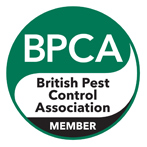PESTMAN - Information about types of pests Insects
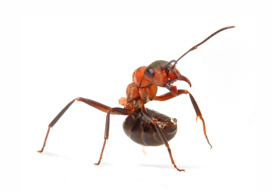
Ants
The Black Garden Ant or Common Black Ant (Lasius niger) is regarded as a native species in the UK and can successfully survive outdoors all the year round. The Black Ant can have large colonies in close proximity to dwellings. They may enter buildings to forage for food. One successful foraging Ant is able to communicate the information to her co-workers, with the inevitable result of vast numbers of worker Ants invading and incidentally contaminating suitable human foods.
An ant nest can contain many thousands of ants and grow bigger as the summer progresses. In late summer winged females and adult males leave the nest and mate. The males die whilst the females find a new nest site.
The Pharaoh’s Ant is much smaller than the Black Ant with the worker Ants being around 2mm long with the males 3mm and the queens 4mm. The worker Ants are light yellow with a darker tip to the abdomen.
Pharaoh’s Ants differ from other UK Ant species in that an infestation consists of more than one nest and the ants move freely between nests. Pharaoh’s Ant colonies contain several queens, all of which may lay eggs.
In the UK the Pharaoh’s Ant can be a problem in hospitals, prisons and other institutions and increasingly in large urban housing blocks as they are attracted to the constant warm temperatures often found in this environment.
Red Ants are often found in gardens and lawns.
 Go to Top
Go to Top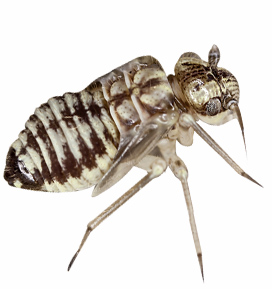
Booklice
Their common name derives from the fact that they can damage old books, particularly if they are poorly stored and can eat the starch paste holding the books together with obvious results.
There are around 800 – 900 species of Booklice (Psocid), the vast majority live outdoors feeding on yeasts, mould and mildews. Some also feed on lichen and algae.
A few species have adapted to live on stored food or in the domestic environment. They can hide in cracks and crevices and eat moulds, fungi and mildew, growing on paper and cardboard packaging. They can be a problem in warehouses and damp conditions within the commercial and domestic setting.
The most frequent found domestic Psocid is Liposcelis bostrychophilus and its common name Booklouse.
Booklouse can be found in domestic and commercial kitchens and is the most likely Booklouse to be involved in customer complaints within the food industry. All adults are female which lay whitish sticky eggs often on food substrate.
 Go to Top
Go to Top
Bed Bugs
The Bed Bug (Cimex lectularius) with their piercing and sucking mouthparts are common throughout the UK and abundant in the south of the England. Although one tends to
associate Bed Bug infestations with dirt and squalor but nothing could be further from the truth with clean well run establishments suffering as well as the more likely premises.
Hotels and hostels are often at risk as it is thought a proportion of Bed Bugs are brought into the country by travellers. This can lead to a serious loss of business and comfort to customers.
Bed Bugs do not live on the host but in the vicinity of the host lurking in all sorts of hiding places, all parts of the bed, headboard, mattress, buttons, behind peeling wallpaper, cracks and crevices, light fittings, electrical sockets, folds and creases in clothes, carpets and floor joints. As a rule of thumb, if you can slide a piece of paper into a crack then a Bed Bug can get in.
Bed Bugs only feed at night on mammalian blood which includes the blood of humans, dogs, cats and rodents. When hungry they search for their prey detecting body heat attracted to an area of carbon dioxide and thus commonly attack the head, neck and shoulders of a victim. They will also feed on the legs or feet if exposed from beneath the bedclothes. Bites are normally in small clusters. Feeding usually takes around 10 minutes. They can eat up to 7 times their body weight in blood in one meal but can go without feed for prolonged periods. Adults are highly resistant to starvation and can survive up to a year without feeding. In normal circumstances they will feed every 2 – 7 days.
 Go to Top
Go to Top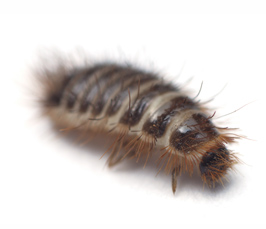
Carpet Beetles
There are two species of beetles commonly known as carpet beetles and both belong to the family of beetles known as Dermestidae. All beetles in this family breed in dry animal proteins and some even breed in meat.
The Variegated Carpet Beetle (Anthrenus verbascii) gets its name from the dense covering of scales of different colours on its wing cases giving it a variegated pattern. It is rather small between 2-4 mm and oval in shape.
The Variegated Carpet Beetle can be particularly significant in domestic properties where they will damage the fibres of carpets, bedding and clothing, animal fur, skins and leather and sometimes the heads of sweeping brushes and mops.
The Fur Beetle (Attagenus pellio) is larger than the Variegated Carpet Beetle at around 4-6 mm and is also known as the Two-Spotted Carpet Beetle due to the adult having a single white or yellowish spot on each of the hardened wing cases. They are otherwise black in colour.
The Fur Beetle is found throughout Europe and widespread throughout the UK. They naturally live in dry bird’s nests where the larvae feed on a diet high in animal protein – feathers and droppings. The Fur Beetle is also found amongst stored grains and cereals.
The Fur Beetle is frequently found indoors. They readily fly through open windows to lay eggs in suitable larval feeding sites, such as edges of carpets, wardrobes and clothing drawers or even bird’s nests in the eaves and roof spaces of houses.
The larvae, commonly known as “woolly bears” will eat woollen clothing and other natural fibres as well as woollen carpets.
 Go to Top
Go to Top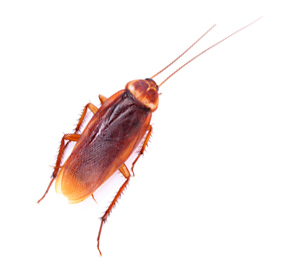
Cockroaches
There are two species of Cockroach regularly found in the UK the Oriental Cockroach and the German Cockroach.
The Oriental Cockroach (Blatta orientalis) also known as the Black Beetle is very common in Britain. As the name suggests it originates from the Far East possibly in North Africa. The adult Oriental Cockroach are dark brown and about 20-25 mm long.
The Oriental Cockroach is known to carry some pathogenic bacteria, although direct
evidence for disease transmission to humans is scarce. The incidental damage caused by fouling and tainting of foodstuffs and non-food materials (sterile hospital supplies) is of greater financial significance.
Infestations in commercial restaurants and institutions are taken very seriously by
Environmental Health Departments. Prosecutions can arise under food safety and
environmental legislation.
The Oriental Cockroach will lurk in heated buildings, ducting, shafts, drains, lose fitting or any dead space. They will eat almost anything being true scavengers.
The German Cockroach (Blattella germanica) also known as the Steamfly is a small buff or dark yellow colour cockroach at 12-16 mm. They like a warm, moist environment such as inside motor housings of fridges and other machines, drink dispensing machines, drink coolers, in voids and behind door seals.
The German Cockroach is known to carry and spread various human disease organisms. Its habit of walking over and feeding on putrefying waste materials, drinking at unsavoury water supplies, and then freely walking over food preparation areas, cutlery and crockery, and human foods in its search for further food enables it to spread many disease
organisms.
Although the Oriental Cockroach and German Cockroaches are the most common species found in the UK there are a small number of other species that may be discovered. These can include the American Cockroach, the Australian Cockroach and the Brown-Banded Cockroach.
 Go to Top
Go to Top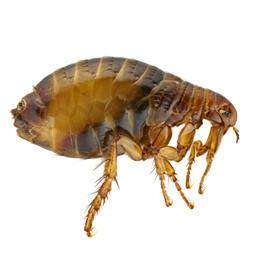
Fleas
Fleas belong to an order of insects known as Syphonaptera. 1,400 species of fleas have been identified with around 60 species having been found in the UK. Generally the fleas mostly found in the domestic situations that bite humans are cat or dog fleas. Adult fleas are wingless and vary in colour from grey to dark mahogany. Their mouth parts are
designed to suck blood from the host animal.
The cat and dog flea are small insects between 2-3 mm long and reddish brown in colour. The cat flea spends a variable proportion of its time off the host, resting in the cats
bedding area. The female flea lays their eggs which often fall off the host onto the animals bedding then hatch in 2 to 3 days.
There is little evidence to suggest that cat and dog fleas transmit any serious illness to humans. However, flea bites on humans and especially children are quite painful and
irritating.
 Go to Top
Go to Top
Mosquitos
There are some 2,500 species of mosquito in the world with about 30 present in the UK. These include the largest group the Culicine Mosquitos found in the UK which includes the Common Gnat (Culex pipens), and the Anopheline group of Mosquitoes all of which include all of which bite humans.
The female mosquito take blood from humans and pets resulting in physical annoyance and sometimes severe discomfort from the body’s allergic reaction to the bites. They are often found near stagnant water, ponds, ditches and salt marches. They will attack people 2-3 miles from their breeding grounds.
Mosquitoes are associated with serious diseases in other parts of the world and still
account for more deaths in humans than any other cause. Malaria kills 1-2 million children every year. Other diseases include Western Nile Virus, Yellow Fever and many others.
 Go to Top
Go to Top
Moths
The Brown-Tail Moth (Euproctis chrysorrhoea) adult has a tuft of brown hairs at the rear of the abdomen which are very noticeable in the female. The abdomen is dark whilst the wings are white. The larvae or caterpillars are very striking with dark hairs and red spots.
The Brown-Tail Moth cause damage to a range of plant species including Blackthorn,
Hawthorn, Sea Buckthorn and many fruit trees plus several deciduous forest and woodland trees such as oak and sallow.
The dark hairs on the larvae can cause considerable irritation to humans. The hairs come easily detached may blow in the wind and cause painful rashes on the skin of people living or working nearby or coming into contact with infested bushes. Many of the hairs are barbed and will resist washing and brushing off. The problem will be more serious if hairs get into eyes. Some people have been known to go into anaphalytic shock which
necessitates urgent hospital treatment.
The Common Clothes Moth and Case Bearing Moth have larvae with eat any natural fibre containing Keratin. They will eat natural fibres including wool, cotton, silk, feather and fur. Infestations often come from bird, wasp and bee nests.
The Case Bearing Moth will leave behind discarded silk tubes which held the larvae. These are off white and about 6-8 mm in length. They will cause damage to woollen carpets eating them to the backing.
Moths will invade food stores and pantries laying their eggs near sources of food so that when the larvae hatches a plentiful supply of food is available.
 Go to Top
Go to Top
Wasps
Wasp’s nests are commonly found in loft spaces, cavity walls, behind structural cladding and in flower beds. A wasp colony may reach between 3,000 to 30,000 wasps. It can prove to be very dangerous if a wasp nest is disturbed by accident incidents can include children collecting a miss-kicked ball from a hedge, golfers probing a hedge line to try and retrieve a wayward ball and DIY people cutting down overgrown hedges.
If a wasp is harmed or crushed it will emit a series of distress chemicals that further
irritates other defending wasps thus provoking them to attack.
The female worker will use her sharp hollow needle structures attached to a venom sack sited at the tip of the abdomen to sting her enemy. Unlike a Bee the wasp can multi-sting. The venom is haemolytic, haemorrhagic and neurotoxic. The venom included histamine which causes the redness, flare and weal in skin.
For most human victims of a wasp sting they will suffer pain and be uncomfortable for a few days and nothing more. However for some it can lead to their body going into
anaphalytic shock which can be fatal.
 Go to Top
Go to Top